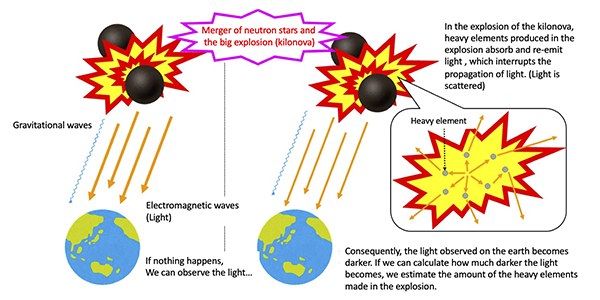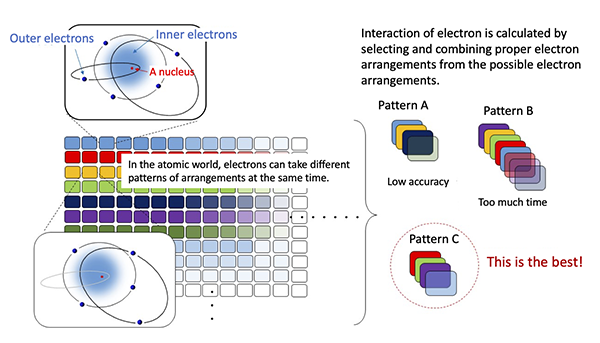HOME > Research Activities > Research Updates >
Computing atomic data of the highest precision
Various kinds of elements exist around us. Almost all of the elements were created in the universe.※ It is believed that the universe was born by the Big Bang of the phenomena such as the big explosion. Then, light elements such as hydrogen and helium and so on were made.
After that, the elements gathered and the stars were born. The heavier elements such as oxygen, carbon and iron were made by nuclear fusion in the stars. But, because iron is the most stable element, heavier elements than iron cannot be made by fusion reaction in the normal star. It is not yet identified where and how elements heavier than iron have been made in the universe. The origin of heavy elements is a long-standing mystery in astronomy. This time, we will show that the National Institute for Fusion Science (NIFS) greatly contributes towards elucidating this mystery.
In recent years, drawing attention as one of the origins of the heavy elements is a merger of two neutron stars. A neutron star is literally a star made mainly of neutrons. Though its mass is as large as the sun, its diameter is only about twenty km. You may have learned that the gravitational waves caused by the merger of two neutron stars were detected in August 2017 for the first time in human history. At the same time, emission of the light with the explosion called "kilonova" was also observed with the gravitational waves. It is believed that precious metals such as gold and platinum, and many heavy elements such as rare earth metals which are indispensable to our lives were made in the explosion of this kilonova.
Elements have the property of absorbing light. The wavelength of the light and the degree of its absorption are unique to each element and they are called atomic data. By using this atomic data, we can estimate the species and the abundance of heavy elements made by the merger of the neutron stars by analyzing the brightness and the wavelength distributions of the light of a kilonova. However, the available atomic data of heavy elements are extremely limited in widely used world standard databases.
In the fusion research, atomic data is necessary to analyze the quantity and transport of a small amount of impurities such as iron mixed in the high temperature plasmas. The National Institute for Fusion Science (NIFS) is building highly accurate atomic data using the computer in the international collaboration with Lithuania. Although the species of the elements that the fusion research has studied so far are different from the species of the elements that the analysis of kilonova needs, methods of the computation can be applied for the light of a kilonova. So, the National Institute for Fusion Science (NIFS) started the research for constructing atomic data of heavy atomic elements for the analysis kilonovae in collaboration with the astronomical fields.
The research team focused on neodymium which has the largest influence on the light absorption of kilonovae. For obtaining atomic data, it is necessary to compute many electrons that have influence on the electrons of one another in the elements. The computation of this interaction becomes more difficult and larger as the number of electrons increases. Because Neodymium contains more electrons than relatively light elements such as iron, it requires a huge amount of time to compute just by applying the calculation code used in fusion research.
The computation of electron interaction used a method of selecting and combining some electron arrangements from the assumed electron arrangements. The research team made many trials for finding an appropriate combination of the arrangements of the electron in order to make accurate computations. Finally, the best combination was obtained. By this, the research team achieved calculation code obtaining atomic data for a relatively short time. By using this calculation code, the research team executed the large-scale computation using the computer of the National Institute for Fusion Science (NIFS) and that of Vilnius University in Lithuania. As the results, we could obtain atomic data of approximately three million wavelengths of light which neodymium absorbs. Only a small part of these data has been observed in the experiments, but when the research team compared those experimental data with this computation, the accuracy was significantly improved compared to the previous computation and we could confirm that computation results present the most accurate data in the world.
Thus, by methods of computation developed by fusion science, the research team could obtain the atomic data at the highest precision which is necessary for analysis of kilonova. It is expected that this data will greatly advance research to elucidate the origins of heavy metals in the universe.
※ Though an artificially made element exists, it is unstable, thus, it rarely exists in nature.
Fig.1

Schematic of absorption and reemission of light by heavy elements in the kilonova
Fig.2

Schematic Image of a computation of electron interaction
